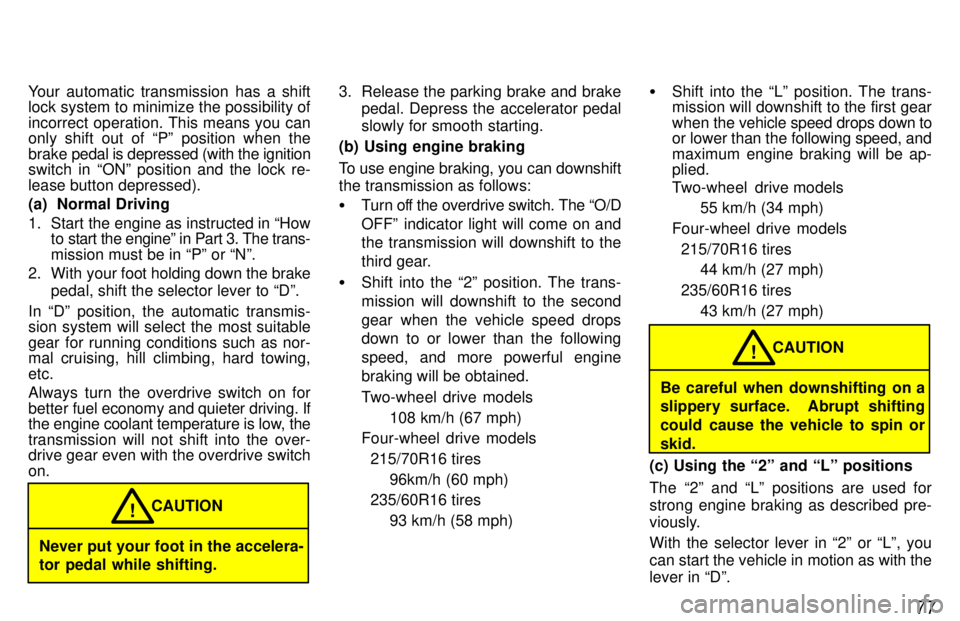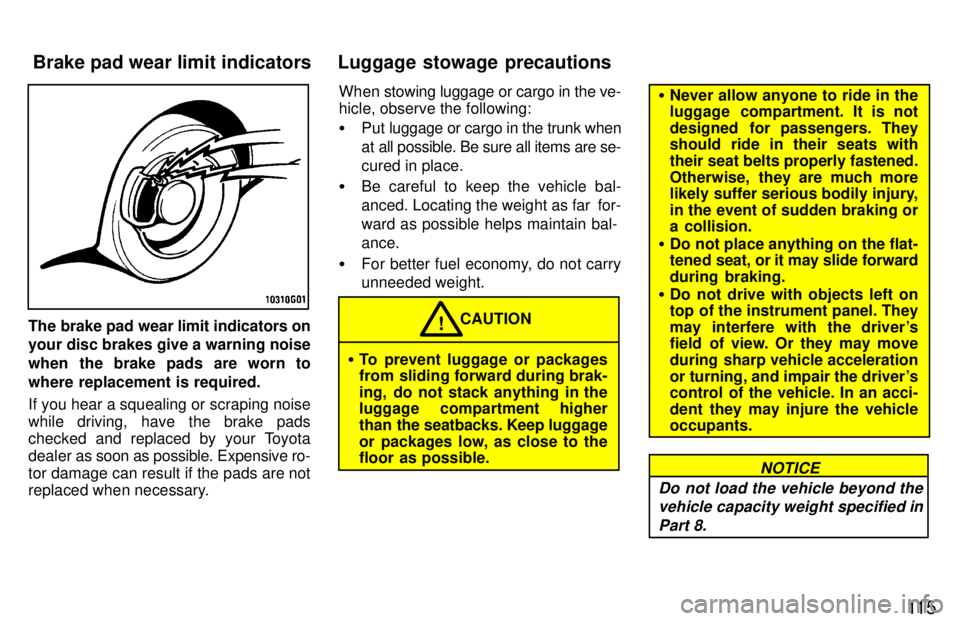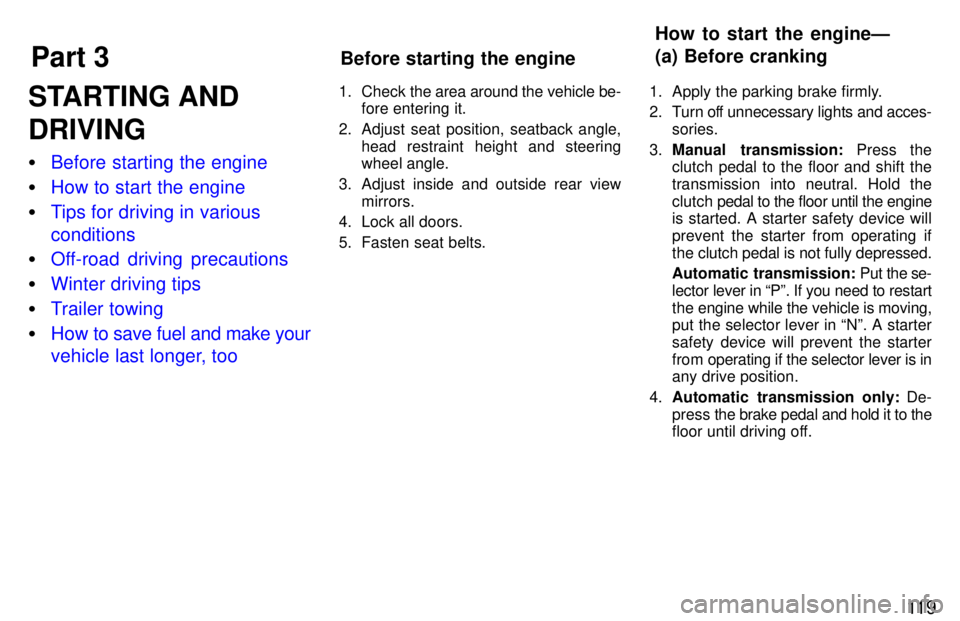1997 TOYOTA RAV4 towing
[x] Cancel search: towingPage 19 of 198

18
Install the removed sun roof panels on
the back door as follows.
If the rear seats are reclined, return
them to the upright position before
closing the back door. Otherwise,they will interfere with the installed sun roof panels, possibly damagingthem.
NOTICE
1. Remove the holder from the back door by turning the bolts counter- clockwise.
The upper holder is for the front sun roof
panel and the lower one is for the rear panel.2. Set the front edge of the sun roof panel into the holders.
The fore part of holders is for the front sun roof panel and the back part is for the rearpanel.
ÐStowing
Page 36 of 198

35
To release the belt, press the buckle-
release button.The rear seat belts can be stowed
when not in use.
Seat belts must be stowed before you fold
the seatback. (See Rear seats-Folding
up rear seatsº in this chapter.) If your seat belt cannot be fastened se- curely because it is not long enough, a
personalized seat belt extender is avail-
able from your Toyota dealer free of charge.
Please contact your local Toyota dealer
so that the dealer can order the proper re-
quired length for the extender. Bring the heaviest
coat you expect to wear for prop-
er measurement and selection of length.
Additional ordering information is avail-
able at your Toyota dealer.
ÐStowing the rear seat belts (4-door models)
ÐSeat belt extender
Page 72 of 198

70
The gauge indicates the engine cool-
ant temperature when the ignition
switch is on. The engine operating
temperature will vary with changes in weather and engine load.
If the needle moves into the red zone, your engine is too hot. If your vehicle
overheats, stop your vehicle and allow the
engine to cool.
Your vehicle may overheat during severe operating conditions, such as: � Driving up a long hill on a hot day.
� Reducing speed or stopping after high
speed driving. �
Idling for a long period with the air con-
ditioning on in stop-and-go traffic.
� Towing a trailer
NOTICE
�Do not remove the thermostat in
the engine cooling system as this
may cause the engine to overheat. The thermostat is designed tocontrol the flow of coolant to keep
the temperature of the engine within the specified operatingrange.
�Do not continue driving with an
overheated engine. See If yourvehicle overheatsº in Part 4.The tachometer indicates engine
speed in thousands of rpm (revolu-
tions per minute). Use it while driving
to select correct shift points and to
prevent engine lugging and overrev- ving.
Driving with the engine running too fast
causes excessive engine wear and poor
fuel economy. Remember, in most cases
the slower the engine speed, the greater
the fuel economy.
NOTICE
Do not let the indicator needle get into the red zone. This may cause
severe engine damage.
Tachometer
Engine coolant temperature gauge
Page 79 of 198

77
Your automatic transmission has a shift
lock system to minimize the possibility of
incorrect operation. This means you can
only shift out of Pº position when the brake
pedal is depressed (with the ignition
switch in ONº position and the lock re-
lease button depressed). (a) Normal Driving
1. Start the engine as instructed in How to start the engineº in Part 3. The trans- mission must be in Pº or Nº.
2. With your foot holding down the brake pedal, shift the selector lever to Dº.
In Dº position, the automatic transmis-
sion system will select the most suitable
gear for running conditions such as nor-
mal cruising, hill climbing, hard towing, etc.
Always turn the overdrive switch on for
better fuel economy and quieter driving. If
the engine coolant temperature is low, thetransmission will not shift into the over-
drive gear even with the overdrive switch on.
Never put your foot in the accelera- tor pedal while shifting. CAUTION
! 3. Release the parking brake and brake
pedal. Depress the accelerator pedal
slowly for smooth starting.
(b) Using engine braking
To use engine braking, you can downshift the transmission as follows: � Turn off the overdrive switch. The O/D
OFFº indicator light will come on and the transmission will downshift to the
third gear.
� Shift into the 2º position. The trans-
mission will downshift to the second
gear when the vehicle speed drops down to or lower than the following speed, and more powerful engine
braking will be obtained.
Two-wheel drive models
108 km/h (67 mph)
Four-wheel drive models 215/70R16 tires
96km/h (60 mph)
235/60R16 tires
93 km/h (58 mph) �
Shift into the Lº position. The trans- mission will downshift to the first gear
when the vehicle speed drops down to
or lower than the following speed, and
maximum engine braking will be ap- plied.
Two-wheel drive models
55 km/h (34 mph)
Four-wheel drive models 215/70R16 tires 44 km/h (27 mph)
235/60R16 tires 43 km/h (27 mph)
Be careful when downshifting on a
slippery surface. Abrupt shifting
could cause the vehicle to spin orskid. CAUTION
!
(c) Using the 2º and Lº positions
The 2º and Lº positions are used for
strong engine braking as described pre-
viously. With the selector lever in 2º or Lº, you
can start the vehicle in motion as with the
lever in Dº.
Page 80 of 198

78With the selector lever in 2º, the vehicle
will
start in the first gear and automatically
shift to the second gear.
With the selector lever in Lº, the trans-
mission is engaged in the first gear.
NOTICE
�Be careful not to overrev the en-
gine. Watch the tachometer to
keep engine rpm from going intothe red zone. The approximatemaximum allowable speed for
each position is given below foryour reference:Two-wheel drive models
2º 130 km/h (80 mph). . . . . .
Lº 72 km/h (44 mph) . . . . .
Four-wheel drive models
215/70R16 tires 2º 121 km/h (75 mph). . . . . .
Lº 67 km/h (41 mph) . . . . .
235/60R16 tires 2º 188 km/h (73 mph). . . . . .
Lº 65 km/h (40 mph) . . . . .
�Do not continue hill climbing or
hard towing for a long time in the
2º or Lº position. This may
cause severe automatic transmis-sion damage from overheating.
To prevent such damage, Dºposition should be used in hillclimbing or hard towing.
(d) Backing up
1. Bring the vehicle to a complete stop.
2. With the brake pedal held down with your foot, shift the selector lever to the
Rº position.
NOTICE
Never shift into reverse while the vehicle is moving.
(e) Parking
1. Bring the vehicle to a complete stop.
2. Pull the parking brake lever up fully to securely apply the parking brake.
3. With the brake pedal pressed down, shift the selector lever to the Pº posi- tion.
While the vehicle is moving, never
attempt to move the selector lever
into Pº position under any circum-
stances. Serious mechanical dam-
age and loss of vehicle control mayresult. CAUTION
!
(f) Good driving practice � If the transmission is repeatedly up-
shifted and downshifted between third
gear and overdrive when climbing a
gentle slope, the overdrive switch
should be turned off. Be sure to turn the switch on immediately afterward.
� When towing a trailer, in order to main-
tain engine braking efficiency, do notuse overdrive.
Always keep your foot on the brake
pedal while stopped with the engine
running. This prevents the vehicle
from creeping. CAUTION
!
Page 83 of 198

81
�
When towing a trailer, in order to main-
tain engine braking efficiency, do not
use the fifth gear.
Be careful when downshifting on a
slippery surface. Abrupt shifting
could cause the vehicle to spin orskid. CAUTION
!
NOTICE
Make sure the vehicle is completely stopped before shifting into
reverse.
The center differential lock system is pro-
vided for use only when the vehicle does not have enough traction to move itself out of the following situations. � All front wheels or rear wheels are off the ground or on a slippery surface.
� One of the four wheels is off the ground or on a slippery surface.
Operating precautions � If the front wheels and rear wheels are
worn unevenly, the center differential
may not lock or unlock smoothly.
� Before locking the center differential,
make sure the wheels have stopped spinning. �
Unlock the center differential immedi-
ately after you finish using the center
differential lock system. An indicatorbuzzer will sound while the center dif-ferential is being unlocked.
� After you have pushed the center dif-ferential lock switch to lock and moved
the vehicle a short distance, the indi-
cator light in the instrument panel
stays on. If the light either fails to come
on or goes out, ask your Toyota dealer
to check the electrical system and the
locking mechanism.
The center differential must be un- locked in normal driving. Locking the center differential will result in
difficult cornering control. CAUTION
!
NOTICE
Do not drive on a dry paved surface with the center differential locked.
This may damage the lockingmechanism and the drive system.
Center differential lock system (four-wheel drive models with manual transmission)
Page 116 of 198

11 5
The brake pad wear limit indicators on your disc brakes give a warning noise
when the brake pads are worn to
where replacement is required.
If you hear a squealing or scraping noise
while driving, have the brake pads
checked and replaced by your Toyota
dealer as soon as possible. Expensive ro-
tor damage can result if the pads are not
replaced when necessary. When stowing luggage or cargo in the ve-
hicle, observe the following: �
Put luggage or cargo in the trunk when
at all possible. Be sure all items are se-cured in place.
� Be careful to keep the vehicle bal-
anced. Locating the weight as far for-
ward as possible helps maintain bal-ance.
� For better fuel economy, do not carry unneeded weight.CAUTION!
� To prevent luggage or packages
from sliding forward during brak-
ing, do not stack anything in the
luggage compartment higher
than the seatbacks. Keep luggage
or packages low, as close to the
floor as possible.
� Never allow anyone to ride in the
luggage compartment. It is not
designed for passengers. They
should ride in their seats with
their seat belts properly fastened.
Otherwise, they are much more
likely suffer serious bodily injury, in the event of sudden braking or a collision.
� Do not place anything on the flat-
tened seat, or it may slide forward
during braking.
� Do not drive with objects left on
top of the instrument panel. They
may interfere with the driver's
field of view. Or they may move
during sharp vehicle acceleration
or turning, and impair the driver's
control of the vehicle. In an acci-
dent they may injure the vehicle occupants.
Do not load the vehicle beyond the
vehicle capacity weight specified in
Part 8.
NOTICE
Brake pad wear limit indicators Luggage stowage precautions
Page 120 of 198

Part 3How to start the engineÐ
(a) Before cranking
Before starting the engine
11 9
STARTING AND DRIVING �
Before starting the engine
�How to start the engine
�Tips for driving in various conditions
�Off-road driving precautions
�Winter driving tips
�Trailer towing
�How to save fuel and make your
vehicle last longer, too
1. Check
the area around the vehicle be-
fore entering it.
2. Adjust seat position, seatback angle, head restraint height and steering
wheel angle.
3. Adjust inside and outside rear view mirrors.
4. Lock all doors.
5. Fasten seat belts. 1. Apply the parking brake firmly.
2. Turn off unnecessary lights and acces-
sories.
3. Manual transmission: Press the
clutch pedal to the floor and shift the
transmission into neutral. Hold theclutch pedal to the floor until the engine
is started. A starter safety device willprevent the starter from operating if
the clutch pedal is not fully depressed.
Automatic transmission: Put the se-
lector lever in Pº. If you need to restart
the engine while the vehicle is moving, put the selector lever in Nº. A starter
safety device will prevent the starter
from operating if the selector lever is in
any drive position.
4. Automatic transmission only: De-
press the brake pedal and hold it to the
floor until driving off.